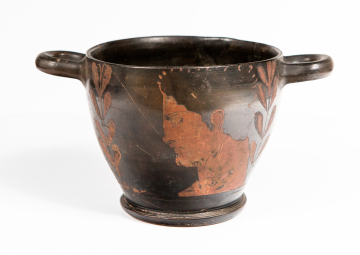Explore Collections


You are here:
CollectionsOnline
/
An Campanian (Greek) skyphos (two-handled deep wine cup) of Attic (Type A) shape.
Browse
An Campanian (Greek) skyphos (two-handled deep wine cup) of Attic (Type A) shape.
Second half 5th century BC
Campania
Fine pale yellowish-brown clay, glazed and incised
Height: 10.8cm
Diameter (rim, excluding handles): 14.5cm
Diameter (foot): 9.2cm
Diameter (rim, excluding handles): 14.5cm
Diameter (foot): 9.2cm
Museum number: L35
On display: Library-Dining Room
All spaces are in No. 13 Lincoln's Inn Fields unless identified as in No. 12, Soane's first house.
For tours https://www.soane.org/your-visit
Curatorial note
Technique: interior and walls black-glazed with superimposed decoration in pinkish-orange, through which details have been incised; underside of the foot reserved with two concentric circles in dilute glaze and traces of red wash.
Decoration: on either side, two red bands mark the lower edge of the figured area, while the horizontal borders are marked by upright sprays of oval, un-veined leaves, probably of olive, shown in added pinkish orange.
Side A:
A beardless male head is shown in profile to left. His face and neck are shown in the added colour, with details of eyes, eyebrows, ear, mouth and chin incised, while his hair is formed by the black glaze of the body of the vase, outlines by short strokes of added colour.
Side B:
In added colour, a male, cloven-hoofed animal, with horns like those of the young stag but a beard that suggests he is more probably a goat, standing to right. The inner details of the figure - neck, beard, ears, shoulders, legs etc. - are again incised through the added pinkish-orange.
The shape of this skyphos suggests it is likely to date to the second half of the fifth century BC, ie 450-400 BC. The pale colour of the clay and the technique suggest the probability that this piece was made in Italy, probably by Etruscans of Faliscans in Campania, where variations on this technique were practised over a long period from about 480 to at least 350 BC.
This entry was compiled by Dr Lucilla Burn of the Fitzwilliam Museum after the restoration of this badly broken item (2003): Cornelius Vermeule did not see the fragments of this piece and therefore did not write a catalogue entry.
Decoration: on either side, two red bands mark the lower edge of the figured area, while the horizontal borders are marked by upright sprays of oval, un-veined leaves, probably of olive, shown in added pinkish orange.
Side A:
A beardless male head is shown in profile to left. His face and neck are shown in the added colour, with details of eyes, eyebrows, ear, mouth and chin incised, while his hair is formed by the black glaze of the body of the vase, outlines by short strokes of added colour.
Side B:
In added colour, a male, cloven-hoofed animal, with horns like those of the young stag but a beard that suggests he is more probably a goat, standing to right. The inner details of the figure - neck, beard, ears, shoulders, legs etc. - are again incised through the added pinkish-orange.
The shape of this skyphos suggests it is likely to date to the second half of the fifth century BC, ie 450-400 BC. The pale colour of the clay and the technique suggest the probability that this piece was made in Italy, probably by Etruscans of Faliscans in Campania, where variations on this technique were practised over a long period from about 480 to at least 350 BC.
This entry was compiled by Dr Lucilla Burn of the Fitzwilliam Museum after the restoration of this badly broken item (2003): Cornelius Vermeule did not see the fragments of this piece and therefore did not write a catalogue entry.
Literature
Agora, XII, pl. 259, nos. 343-6.
J. D. Beazley, Etruscan Vase Painting, Oxford, 1947, pp 195-229.
G. Pianu Mélanges de l'Ecole Française de Rome, 1978, pp. 161-95.
J. M. Padgett and others, Vase Painting in Italy, Boston, 1993, pp. 228-33.
J. D. Beazley, Etruscan Vase Painting, Oxford, 1947, pp 195-229.
G. Pianu Mélanges de l'Ecole Française de Rome, 1978, pp. 161-95.
J. M. Padgett and others, Vase Painting in Italy, Boston, 1993, pp. 228-33.
Soane collections online is being continually updated. If you wish to find out more or if you have any further information about this object please contact us: worksofart@soane.org.uk


